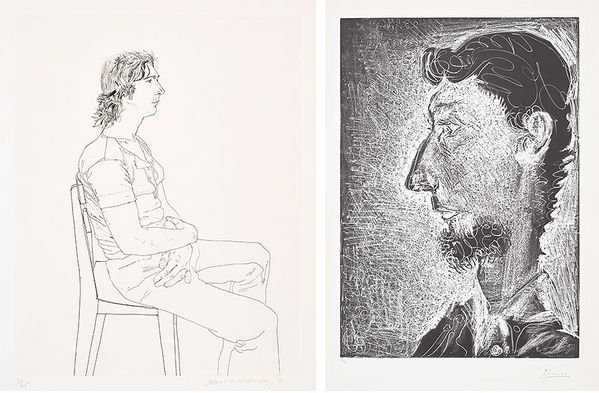David Hockney, Maurice Payne (S.A.C. 123, M.C.A.T. 115), 1971. David Hockney. Pablo Picasso, Portrait de Piero Crommelynck II (Portrait of Piero Crommelynck II) (Bl. 1378, Ba. 1400), 1966. Evening & Day Editions, London.
Inspired by the upcoming slate of Editions auctions in London, we tasked our specialist team to play matchmaker between David Hockney — the subject of a dedicated auction on 13 September — and his Modern and Contemporary forebears featured in our 14-15 September Evening & Day Editions auctions. With just a *little* artistic license, the result explores creative parallels, imagined conversations, and subjects of fascination that link Hockney to fellow artists of the 20th century.
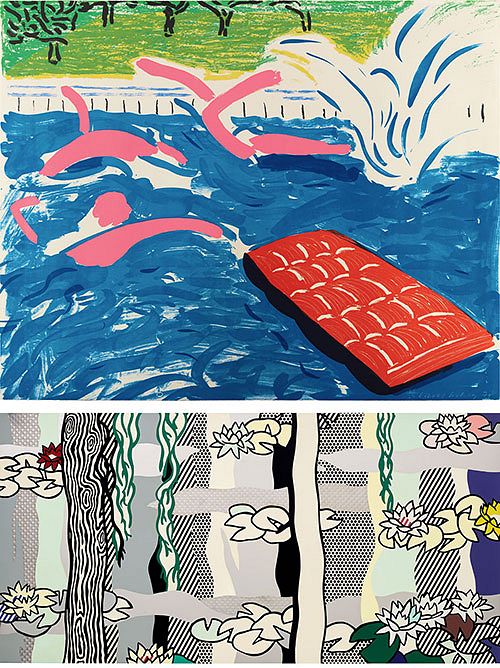
David Hockney, Afternoon Swimming, 1979. David Hockney. Roy Lichtenstein, Water Lilies with Willows, from Water Lilies, 1992. Evening & Day Editions, London.
Swim Lessons: Hockney and Lichtenstein
Rebecca Tooby-Desmond, Head of Sale, Editions
Take it from a Pisces, the water’s where you want to be. Dive into Hockney’s cool, crisp California pool in your tightest speedos and let the sparkling water sluice off daily drudgery. Or take a leisurely breaststroke, brushing aside Lichtenstein’s heady-scented lilypads as the low sun glints under the brim of your straw hat. I’ll don my woolly beanie come winter at the Hampstead ponds, but it doesn’t matter the waters you take. Be it hard-edged and full of holiday promise, drenched in late summer sun and old school glamour, or cold and ritually familiar. Ponds, lakes, pools, the sea — the water is always wild and free.

David Hockney, The Arrival of Spring in Woldgate, East Yorkshire in 2011 (twenty eleven) - 30 May, 2011. David Hockney. Joan Miró, Le roi des lapins (The Rabbit King) (D. 1130), 1981. Evening & Day Editions, London.
Down the Path: Hockney and Miró
Louisa Earl, Associate Specialist/Cataloguer
A leap and a bound along the lane
A hop, a stop, a dawdle without aim
The green is calling, leaves rustle above
Spring is here for the rabbit, blooming with love
Blue skies shine bright, only pleasures await
Nibbles abundant to fill up a plate
Clippity-clop, ears perk up, oh my, what’s that sound?
Hooves approaching, quick hide!, cover those ears, don’t be found
It grows quiet once more, peek out, nose first
Whiskers second, and finally, a tail with a burst
Into the fountain of long grass like a dart
Oh to be a rabbit when spring does start
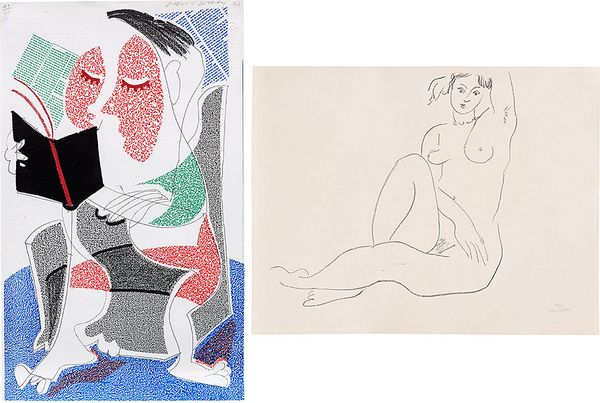
David Hockney, Man Reading Stendhal, July 1986 (M.C.A.T. 302), 1986. David Hockney. Henri Matisse, Nu assis, bras gauche sur la tête (Nude Seated, Left Arm Overhead) (D. 497), 1929. Evening & Day Editions, London.
Line Leaders: Hockney and Matisse
Grace Brown, Associate Researcher
Lines are the most elemental gesture or stroke of an artist. Lines can outline, describe, and define. They communicate information, convey expression, and lead your eye around a composition. In Nu Assis, bras gauche sur la tête and Man Reading Stendhal, Henri Matisse and David Hockney explore the visual impact of meandering lines, using them to conjure up human forms in their respective works. For Matisse, fluid lines create voluptuous curves and soft edges, producing a sensual and seductive image. Meanwhile, Hockney’s wandering lines mirror the roaming imagination of his abstracted reader who sits immersed in a literary realm. Whether used sparingly to create minimalistic, intimate lithographs as Matisse does, or combined with bold colours and textures to great effect as in Hockney’s home-made print, both artists demonstrate the versatility, expressiveness, and visual importance of line.
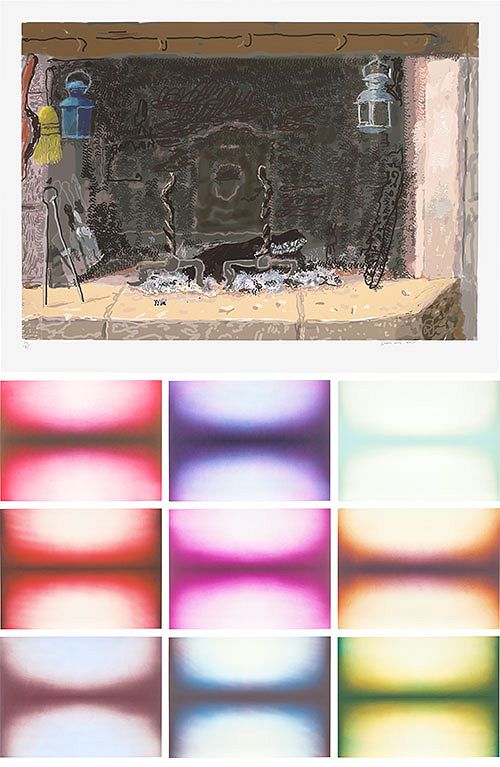
David Hockney, No Fire, from My Normandy, 2020. David Hockney. Anish Kapoor, Horizon Shadow, 2010. Evening & Day Editions, London.
Into the Void: Hockney and Kapoor
Georgie Byworth-Morgan, Administrator
Hockney and Kapoor place negative space at centre stage — rebelling against the art historical tradition of using the negative as a compositional device to highlight the positive. Far from a marginal element, in both No Fire and Horizon Shadow, emptiness is the primary subject. Hockney and Kapoor both taunt stereotypical views of picturesque idylls — the hearty fireplace radiating warmth and comfort and the twilight horizon over a vast landscape. In doing so, they push cliché to the peripheral and compel the viewer to focus on what is not there — the intangible, the empty space, the void.
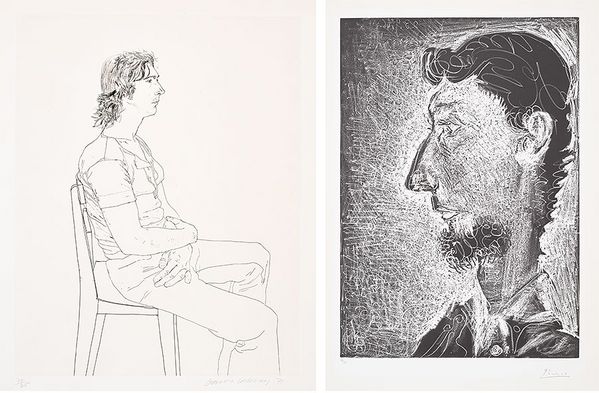
David Hockney, Maurice Payne (S.A.C. 123, M.C.A.T. 115), 1971. David Hockney. Pablo Picasso, Portrait de Piero Crommelynck II (Portrait of Piero Crommelynck II) (Bl. 1378, Ba. 1400), 1966. Evening & Day Editions, London.
Portrait Sittings: Hockney and Picasso
Anne Schneider-Wilson, Senior International Specialist
"I have such a soft spot for the printer."
"Oh really, who are these guys?"
"Maurice Payne, on the left, he was David Hockney’s printer and Piero Crommelynck, on the right, the printer of Pablo Picasso."
"Oh, that’s cool…so, what do they do?"
"They are the ones producing the image onto the printing plate. They have this amazing knowledge of the technical complexities that only very few people truly understand. Look at the end result, how effortless it seems, just one etched line expressing so much! Or that dramatic texture in the background and on his face."
"Wow, now I see it! But these two guys, look at them, they seem a bit sad, no?"
"Nah, just calm and in control. They are the ones in charge. They have the full trust of the artists."
"You are such a print geek!"
"I know, pass me the loupe!"
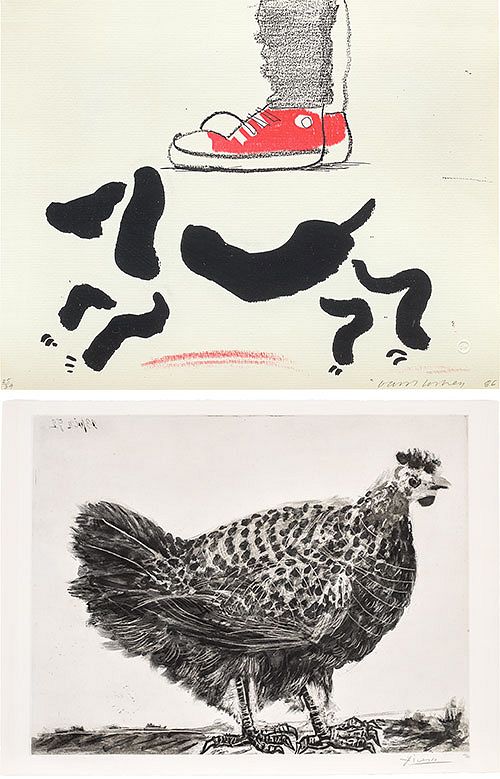
David Hockney, Ian and Heinz, July 1986, 1986. David Hockney. Pablo Picasso, La poule (The Hen) (Bl. 694, Ba. 896), 1952. Evening & Day Editions, London.
Animal Kingdom: Hockney and Picasso
Robert Kennan, Head of Editions, Europe
Picasso loved to surround himself with animals, from owls to goats, companionship and inspiration for his art in equal measure. By contrast, with the exception of the odd sausage dog, Hockney rarely depicts animals. A people person, his menagerie is of the humankind filled with lovers, family and friends. He came late to dog ownership, not until the early 1980s when his then lover, Ian Falconer, introduced him to Heinz the dachshund. Soon after, Stanley and Boogie followed wagging their tales, delightedly becoming especially cherished companions when AIDS took its toll on many from Hockney’s circle. Unlike his primal screaming roosters of more turbulent times, Picasso’s happy hen comes from a period of tranquillity, a time shared with Françoise Gilot in the south of France, with their two young children Claude and Paloma. Hockney never met Picasso but had they done so, with a quick search of their Chinese zodiac signs for compatibility, Picasso the Snake and Hockney the Ox would have become the closest of friends.
Recommended Reading
